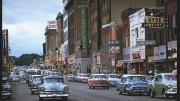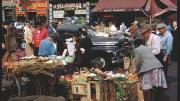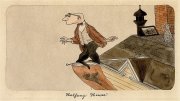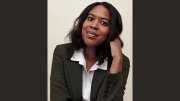What Money Can’t Buy: The Moral Limits of Markets, by Michael J. Sandel, Bass professor of government (Farrar, Straus and Giroux, $27). The proprietor of the vastly popular, long-running, and internationally broadcast “Justice” course ponders the “era of market triumphalism” (cost for an Indian surrogate mother: $6,250) and its limits.
Harvest the Wind, by Philip Warburg ’77, J.D. ’85 (Beacon, $27.95). The author, also an alumnus of the Environmental Law Institute and Conservation Law Foundation, tells the tale of “America’s journey to jobs, energy independence, and climate stability” (the subtitle) through visits with the people involved.
The Day in Its Color, by Eric Sandweiss ’81 (Oxford, $39.95). Quotidian America, captured in Kodachrome images taken during midcentury wanderings by casual photographer Charles Cushman, comprise an amateur visual history in the best sense of the word. Alongside the riveting images, Sandweiss, of Indiana University, offers superb, and suitably unacademic, commentary and context.
Dignity: Its History and Meaning, by Michael Rosen, professor of government (Harvard, $21.95). A succinct exploration in philosophy, political theory, and more, but without the dread difficulties of diving deep into, say, the thickets of Kant. The text begins, “Schopenhauer, the Ebenezer Scrooge of nineteenth-century philosophy… .”
The Founder’s Dilemmas, by Noam Wasserman, associate professor, Harvard Business School (Princeton, $35). Channeling your inner Facebook? You might want to guard against the challenges that fell most startups. From examples in technology and life sciences, Wasserman offers evidence about family, teammates, investors, and other nettlesome, necessary people.
The Mansion of Happiness: A History of Life and Death, by Jill Lepore, Kemper professor of American history (Knopf, $27.95). Taking on three minor questions—“How does life begin? What does it mean? What happens when you’re dead?”—the prolific historian/New Yorker writer explores the history of these ideas through stories, beginning with Milton Bradley, the game guru, and his “Checkered Game of Life.”
Trusting What You’re Told: How Children Learn from Others, by Paul L. Harris, Thomas professor of education (Harvard, $26.95). How children learn things beyond their immediate experience turns on understanding “displaced references,” asking questions, and developing trust in—and moral discrimination about—the answers. Full of vivid, surprising examples—like how kids in meat-eating families opt for vegetarianism.
The Ball, by John Fox, Ph.D. ’94 (Harper Perennial, $14.99 paper). Pursuing “the object of the game,” the author draws on his anthropological training and journalistic skills, while traveling the world and history, to explore why we, universally, play ball.
The Creation of Inequality, by Kent Flannery and Joyce Marcus, Ph.D. ’74 (Harvard, $39.95). Who knew, when these two Distinguished University Professors at Michigan’s Museum of Anthropology began their enormous tome on the ancient origins of “monarchy, slavery, and empire” (from the subtitle), that it would turn out to be timely? A history of the origins of hierarchy won’t make the nightly news, but it is profound food for thought.
Zoobiquity: What Animals Can Teach Us About Health and the Science of Healing, by Barbara Natterson-Horowitz ’83, A.M. ’83, and Kathryn Bowers (Knopf, $27.95). The lead author, a UCLA cardiologist and medical adviser to the local zoo, and her colleague explore lessons from veterinary science—ranging from obesity to stallions’ libido issues.
Alaskan Travels, by Edward Hoagland ’54 (Arcade, $22.95). Hoagland, who managed to be usefully curmudgeonly even in his youth, here revisits sojourns from 30 years ago—involving, as always, the outdoors, lowlifes, himself, sex, and the farther reaches of North America as only he recorded it.
American Gridlock, by H. Woody Brock ’67, M.B.A. ’70, S.M. ’71 (Wiley, $27.95). Addressing economic and entitlements problems through an economic and consulting approach (for example, address healthcare access and cost crisis by increasing the supply of medical services). Although Brock analyzes errors made by the right and the left, will any politicians rally to his fixes?
Blackhorse Riders, by Philip Keith ’68 (St. Martin’s, $26.99). A you-were-there account of a hellish, heroic battle in Vietnam that went unrecognized for decades. The author, who was not in that fight, did serve three tours of duty in the war.
Beyond the Lettered City, by Joanne Rappaport, RI ’09, and Tom Cummins, Dumbarton Oaks professor of pre-Columbian and colonial art (Duke, $25.95 paper). A scholarly investigation of a lively subject: how the imposition of Spanish systems of alphabetic and visual literacy on native peoples affected indigenous cultures in the northern Andes—in effect, illiteracy transformed.
The Great Experiment (Pioneer Institute, $19.95). An analysis of the Massachusetts healthcare law, and the 2010 Affordable Care Act in the state-federal context, by a free-market, limited-government Bay State policy shop. Medical School dean Jeffrey S. Flier’s introduction unloads on the national law, challenging the tax-deductibility of health-insurance premiums, the state of regulation, and the basic design of Medicare and Medicaid.
The Other Side of Normal, by Jordan Smoller ’83, M.D. ’91, S.D. ’01 (Morrow, $27.99). An associate professor of psychiatry and of epidemiology proposes to invert the psychiatric project: rather than delimiting abnormality, he suggests “pursuing the biology and psychology of normal” in order to find new ways to understand and relieve suffering.










